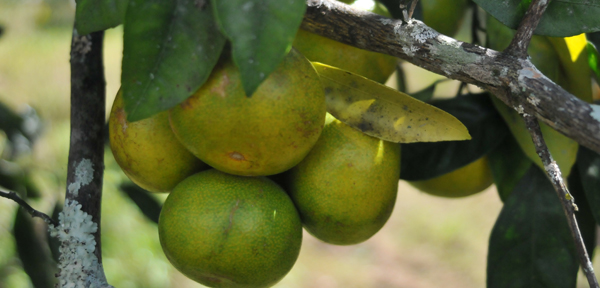
The Hahnville area has been quarantined with a highly infectious bacterial disease called citrus canker and residents are being asked to take steps to help avoid it spreading.
The disease poses no threat to humans, but all types of citrus trees are vulnerable to it, said Rene’ Schmit, the parish’s LSU AgCenter county agent. The fruit grown in this area can be given or sold within the quarantined area, but it must be treated to go outside the area.
Schmit estimated one of every 10 households in the parish has citrus trees. The area’s four citrus growers in Boutte, St. Rose, Paradis and Taft have not been identified with the disease.
“Once the disease is identified nothing can be sold and the trees have to be destroyed,” he said. “It’s a bacterial disease – we have to remove it.”
Tree removal is up to the owner, but diseased trees lose productivity and can die eventually, as well as help spread the problem.
Citrus canker is identifiable by black splotchy markings or legions on leaves, stems and fruit.
The Louisiana Department of Agriculture and Forestry (LDAF) said there is no effective treatment for it. Infected trees can be removed, but it is advisable to inform the LDAF before doing so because the disease can remain in surroundings for up to a year.
All parishes with confirmed reports of the disease are quarantined in an attempt to contain it.
Federal and state quarantine regulations prevent the movement of citrus plants, any plant parts, clippings or fruit out of a quarantined zone.
To date, the entire parishes of Orleans and St. Bernard have been quarantined with the disease, along with portions of St. Charles Parish and Jefferson, Lafourche and Plaquemines parishes.
Richard Miller, LDAF’s administrative coordinator of quarantine programs, confirmed citrus canker is in the Hahnville area and that area has grown gradually.
Miller emphasized the basic rule is “If you buy it in the parish you leave it in the parish” in an attempt to contain the disease.
The two biggest issues with the disease are fruit and nursery trees, he said.
Infected fruit can be moved out of the parish if treated with sodium hypochloride.
Federal restrictions also require that tools, equipment and personnel performing any service work on properties where a citrus tree is present must be disinfected with a bacterium-killing solution before leaving the property.
Miller said infected trees spread the disease by wind-driven rain or contaminated tools, clothing and equipment. It can move long distances in large storms such as hurricanes.
Listed from the most susceptible to the least susceptible citrus fruits are: grapefruit, trifoliate oranges, Mexican or Key limes, navel oranges, sour oranges, sweet oranges, lemons, satsumas, tangerines, Mandarin oranges, king oranges and kumquats.
Anyone who believes their trees have citrus canker can contact the U.S. Department of Agriculture at (225) 298-5410 or the Horticulture and Quarantine Division of the Louisiana Department of Agriculture and Forestry at (225) 952-8100. More information about citrus canker is available by calling (225) 578-4562 or emailing rsingh@agcenter.lsu.edu.
The Citrus Canker Factsheet LSU AgCenter Publication 3269 is available by visiting www.LSUAgCenter.com and typing “citrus canker” in the search box.




Be the first to comment